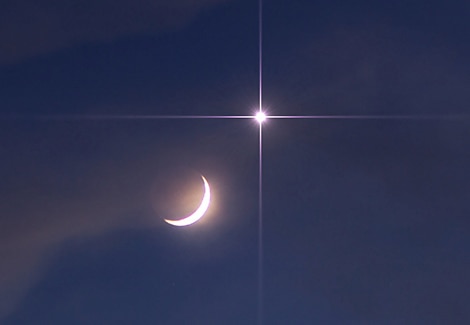Create a free profile to get unlimited access to exclusive videos, sweepstakes, and more!
Venus, Jupiter, the Moon, and the Heart of the Lion

I was perusing Twitter on Saturday and someone mentioned that Venus and the Moon would be close together in the sky that night. I checked my Sky Safari software, and sure enough they’d be about 1° apart at sunset for me. Given that the Moon’s width on the sky is about 0.5°, that’s a nice, tight pairing.
I also knew that Jupiter was still nearby, slowly separating from Venus after their very close encounter a couple of weeks ago (which I only caught glimpses of through thick clouds here after sunset EVERY SINGLE DAY in Colorado, grrrr). Once the Sun set I was outside snapping away. I took about 150 photos, and one really stuck out for me:
That turned out well! The Moon is obvious, with Venus nearby. Jupiter is off to the right, and the bright star Regulus (the “Heart of the Lion,” the star marking the chest of Leo the Lion) above. It’s nice that sometimes the Rocky Mountain foothills provide a dramatic silhouetted backdrop, too.
I have a pretty basic DSLR camera and lens (Canon T4i and a 135 mm telephoto) so my shot is OK, but not fantastic. But when you have great equipment and real talent, you get something like this:
That breathtaking shot is from César Cantú, an astrophotographer in Mexico. He used a star filter to produce the spikes and was able to get a bit more of the earthshine on the Moon than I could. He seems to be unhappy with the clouds where he was, but I think they add a lot of beauty to the picture. I like it when there are terrestrial reminders in wide-sky astrophotos. It gives them more of a sense of presence.
The best terrestrial reminder of all is the Earth itself, especially if the shot is taken from space:
Space Station Commander Scott Kelly took that one and posted it on Twitter. So yeah, location, location, location.
A lot of folks tweeted lovely photos they took to me after the event, too. Searching Twitter can be a pain, but if you look through my mentions around that date you’ll see the photos. Thanks to everyone who took the time to share!
An added bonus to this whole thing is that Venus and the Moon were showing similar phases, too. I had a few people asking why Venus has phases, too, and the good news is this guy explains it pretty well:
It’s funny to me that I might’ve missed this event (or more likely seen it late and then have had to scramble to get shots) had I not seen it on Twitter; I’m usually more on top of sky shows. I’m glad I saw it early in the morning too: Venus is bright enough to be seen during broad daylight, but it’s tough. With the Moon nearby, they’re easier to spot. Given they were more than 30° from the Sun, I knew I could look for them without blinding myself. The irony is I found Venus easily in binoculars, but high cirrus blocked the Moon. It would’ve been nice to see them together, but there’s always a thrill seeing Venus in the middle of the day.
Venus is getting lower every day; it’s getting closer to the Sun in our sky and will be gone by sunset in just a couple of weeks. To make up for it, Mercury is getting higher at sunset, and on Aug. 6 will pass about a half a degree from Jupiter! That’ll be very pretty, so keep your eyes open for it. The pair will only be a few degrees above the horizon at sunset, so it’ll be a tough observation (especially if you have mountains to the west like I do!). I’ll be out with binoculars hoping to see that.
Remember, there’s a lot going on over your head all the time. Try not to miss it.


























